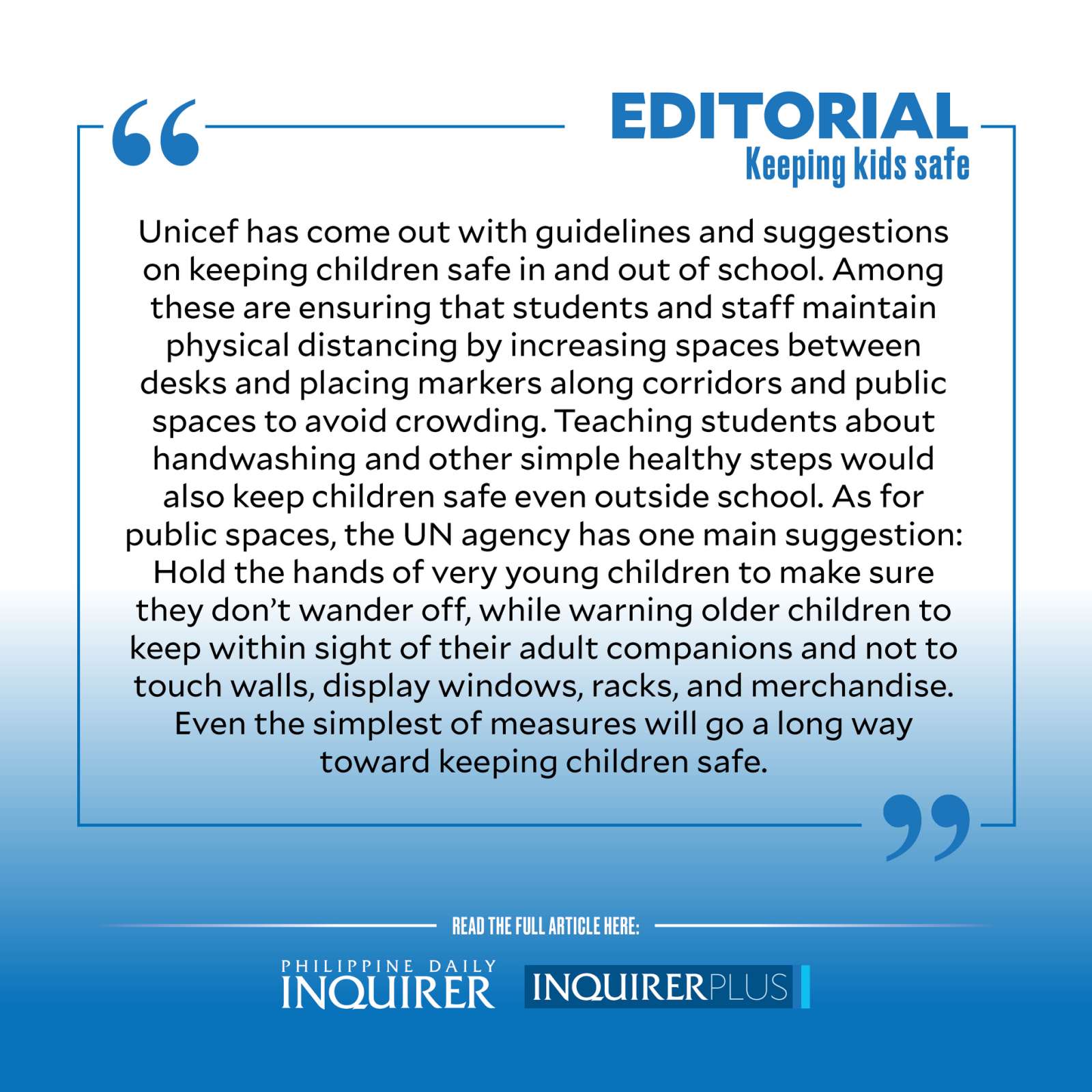Keeping kids safe

It was a sight both touching and heartening. Schoolchildren, many of them clad in freshly-pressed uniforms even if some were shown barefoot, gathered as a group inside a classroom. Yes, an actual classroom with four walls and desks. The only disconcerting element were dividers with curtains of plastic, the government’s way of ensuring no child or teacher ended up being infected.
The temporary (it is hoped) barriers were but one sign that the presence of children in classrooms was taking place amid extraordinary times. But another picture, in today’s parlance, turned viral because it showed soldiers with long firearms prowling an elementary classroom. The image brought back memories of the early days of the COVID-19 pandemic in our shores when the government’s main response against the disease was a heavy-handed armed military presence, complete with armored personnel carriers.
Article continues after this advertisementStill, the back-to-school, face-to-face regimen seemed to lift everybody’s spirits. This, along with falling COVID-19 rates and increasing number of recoveries, signaled things were back to something like normal, or as near-normal as they could get.
No wonder the past weekend exuded a palpable sense of liberation, of relief, as children were suddenly freed from what Inquirer columnist Gideon Lasco called “the unbearable lockdown of Filipino children.” Parks and promenades, among the scarce public open spaces that still exist, and malls, shopping districts, and even markets were filled with families and young folk frolicking, strolling, and breathing in the open air.
And yet, there is still danger and threat lurking amid the spontaneous festivity. As the experience of European countries shows, freedom has a price, as the lifting of COVID-19 controls gave way to, over the last few weeks, a resurgence of infections and even deaths. The virus remains a public health problem. And the sense of relief and fearlessness engendered by the lifting of restrictions only adds to the difficulty faced by public health authorities in reimposing controls and urging the public to maintain vigilance.
Article continues after this advertisementSounding the alarm is Dr. Benito Atienza, president of the Philippine Medical Association, who reminds parents to “still be wary” of bringing their children, many of whom have yet to be vaccinated, to malls or indoor places where they are at risk of exposure to COVID-19.
Dr. Atienza suggested instead that parents prioritize bringing their young ones to parks and open spaces and observe social distancing, among other public health measures.
OCTA research fellow Guido David points out, too, that looking at data from the United Kingdom, which has opened up after the initial COVID-19 threat passed, “there’s a significantly high infection rate among school-age children, about 15 times higher than adults.” David suggests that special attention be paid to the age group between 10 and 14 years old who are still unvaccinated and yet are deemed old enough to navigate the outside world by themselves.
Not surprisingly, the government is only now formulating guidelines on the movement of minors after having eased restrictions early this month. Last Monday in his evening address, President Duterte urged local government units “to consider passing ordinances for age restriction among minors who can be allowed to go to the malls.” This after a two-year-old was reported to have tested positive for COVID-19 after supposedly visiting a mall. LGU executives subsequently convened meetings to discuss how to maintain precautions, especially mask-wearing, for young people.
Meanwhile, there are steps that can be immediately taken to keep children safe as restrictions ease. Unicef has come out with guidelines and suggestions on keeping children safe in and out of school.
Among these are ensuring that students and staff maintain physical distancing by increasing spaces between desks and placing markers along corridors and public spaces to avoid crowding. Staggering classroom hours would also help reduce the number of students in a classroom.
Teaching students about handwashing and other simple healthy steps would keep children safe even outside school. Unicef suggests that teachers think up fun and educational ways to instill handwashing into the daily habits of children, such as composing a fun song. They should also be reminded about coughing and sneezing etiquette, proper wearing of masks, and other simple health and hygiene measures.
As for public spaces, the UN agency has one main suggestion: Hold the hands of very young children to make sure they don’t wander off, while warning older children to keep within sight of their adult companions and not to touch walls, display windows, racks, and merchandise. Even the simplest of measures will go a long way toward keeping children safe.
















